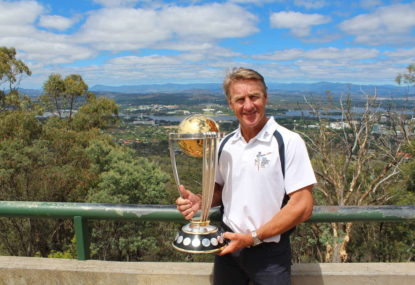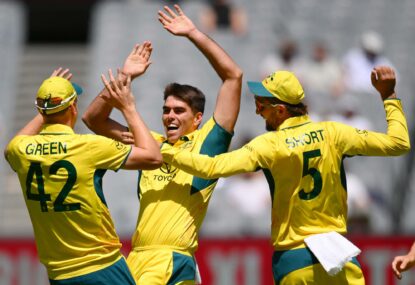After consecutive losses to New Zealand and Pakistan, and with their 1999 World Cup campaign in jeopardy, Australia’s ODI cricket team launched an extraordinary rearguard action which lasted for 12 years.
Over 34 games and against 15 different opponents, Australia went undefeated across the span of four World Cups as they claimed the trophy three times in succession.
At the core of the teams which executed this three-peat were a trio of the greatest 50-over players in history – batsman Ricky Ponting, wicketkeeper Adam Gilchrist and paceman Glenn McGrath.
Together with a supporting cast of supremely-talented players, those legends turned Australia’s ODI lineup into one of the most dominant sporting teams the world has witnessed.
There was not a single weakness in the units Australia took to the 1999, 2003 and 2007 World Cups. Their batting had a level of skill, belligerence and innovation which overwhelmed opposition bowlers.
Their attack utilised its optimum blend of pace, guile and experience to scythe through batting lineups. Their fielding was always clinical and at times miraculous, ensuring their foes were not just constantly on the ropes but also suffered blows they never saw coming.
It all started that day at Leeds in May of 1999 when Pakistan wrong footed Australia. In earning a narrow, 10-run win, the mercurial Pakistanis left Australia with a 1-2 win-loss record for the tournament.
Facing a potentially humiliating early exit from the World Cup, then captain Steve Waugh gathered his players after the match for a frank discussion. Still smarting from the heartache of losing the 1996 World Cup final against Sri Lanka, Waugh told his players nothing less than success could be contemplated from that match forward.
It took famously narrow victories over South Africa in the Super Six and semi-final stages for Australia to get a chance at redemption. By the time they earned a re-match against Pakistan in the 1999 final, they had built a degree of self-belief and momentum that not even the express pace of Wasim Akram and Shoaib Akhtar could counter.
McGrath and spin maestro Shane Warne ran amok at Lords, snaring a combined 6-46 as Pakistan were rolled for 132. By the time opener Gilchrist was dismissed, having caned 54 from 36 balls, Pakistan’s will had been broken and the Cup was headed to Australia.
The Aussies’ next World Cup encounter, four years later, was against that same opponent. This time, Pakistan encountered Australia at a weak moment as they were reeling from Warne’s drugs ban. Bowling first, Pakistan would have felt the game was theirs for the taking after reducing Australia to 4-86, with star batsmen Gilchrist, Matthew Hayden and Damien Martyn all back in the changerooms.
But Australia’s greatest strength throughout their three World Cup triumphs was their depth. When champions like Ponting, Gilchrist, McGrath and Warne were absent or failed, a lesser light shone bright.
Pakistan knew little of explosive all-rounder Andrew Symonds. By innings end they were all too familiar with his punishing striking. His 143no from 125 balls propelled Australia to 310, a total Pakistan never challenged.
Symonds unexpected lead role was indicative of the seemingly endless reserves of talent Australia possessed over these tournaments. Where their opponents typically leaned on three or four key players, Australia seemed to field 11 potential match winners.
In 1999, low-profile swing bowler Damien Fleming was operating in the enormous shadows of McGrath and Warne. Yet, with 14 wickets at an average of 25, he proved to be one of the most influential bowlers of the tournament.
In 2003, a quartet of lesser lights showed they could be just as effective as the team’s stars Ponting, Hayden, Gilchrist, McGrath and Michael Bevan.
While Symonds was making his name slapping 326 runs at 163, the tournament was also a high point in the careers of Chinaman Brad Hogg, seam bowler Andy Bichel and strokemaker Damien Martyn.
None of those four players would have been mentioned in opposition team meetings leading up to the World Cup. By the time Australia had lifted the Cup they had all produced match-turning efforts. No one summed up their surprisingly effective supporting roles better than Bichel.
The unfashionable Queenslander unsuccessfully battled for years to become a permanent member of Australia’s side and will be largely forgotten in history among the team’s gleaming stars.
But on March 2, 2003 he conjured one of the greatest individual performances in the annals of ODI cricket. With 7-20 he sliced through England’s batting lineup as they were rolled for 204. Content with his remarkable spell, Bichel would have returned to the changerooms ready for an afternoon of relaxation.
Instead, he found himself trotting to the crease with Australia nose-to-nose with defeat at 8-135. Coolly, he partnered Michael Bevan in an unbeaten 73-run partnership as Australia snared an unlikely victory.
The Aussies had long talked about their belief that they could win from any position. This attitude became a hallmark of their dominance. On this day, Bichel personified this spirit.
From that match on Australia were a juggernaut, storming their way to another final. Like Pakistan before them, India could not match Australia’s intensity on the biggest stage for 50-over cricket. As Ponting and Martyn sauntered off the ground with an unbroken 234-run partnership in Australia’s first innings total of 2-359, the Indian players sported slumped shoulders and defeated expressions. Predictably, India’s batsmen came nowhere near Australia’s total.
When the 2007 World Cup came around in the Caribbean, Australia once more had doubt surrounding them. Leading into the tournament, they had lost six of their past seven matches, including a 2-0 defeat to England in the home tri-series final, followed by a 3-0 series loss in New Zealand.
Many cricket pundits and fans were suggesting that Australia’s veteran-heavy side was well past its peak. The defending champions eased into the tournament with lopsided matches against Scotland and the Netherlands, beating both sides by more than 200 runs.
It was over the following week that Australia gave notice they remained a rampant unit. First they smashed 377 against the mighty South Africans. Then they tore apart the West Indies’ attack in amassing 322. Finally, their bowlers cut through Bangladesh for just 104, a total Australia surpassed in just 13.5 overs for the loss of no wickets.
Any cricket followers who had doubted they could grab the trophy again had been firmly corrected. Australia’s reign of demolition didn’t stop there. They dispatched England by seven wickets, Ireland by nine wickets, Sri Lanka by seven wickets and New Zealand by 215 runs to book a semi-final against South Africa.
The Proteas were fancied to strongly challenge Australia but instead were embarrassed. They were befuddled by Australia’s pace attack, slumping to 8-103 before Australia waltzed to a seven-wicket win.
Australia completed the most dominant World Cup campaign in cricket history by manhandling Sri Lanka in the final. In a rain-shortened match, Australia sprinted to 4-281 from just 38 overs on the back of a blistering 149 from 104 balls by Gilchrist. Against Australia’s bullet-proof attack Sri Lanka were never likely to near this score and so it was as the defending champions completed the three-peat.
It wasn’t until their sixth match of the 2011 tournament that their startling run of World Cup wins finished. Ironically, it was ended by Pakistan, the very same side that had lit a fuse under Australia early in the 1999 competition, prompting the sequence of 34 victories.
Throughout this rampage, Australia had played with a level of aggression and daring that made engrossing spectacles of even their most one-sided wins. Even opposed to minnows, Australia never exhibited a casual approach.
Shane Warne never stopped trying to turn the ball at acute angles. Brett Lee never stopped trying to vaporise stumps. Gilchrist never stopped trying to punish the ball with his blade. Ricky Ponting never stopped diving desperately to save runs in the field.
Their captains regularly set fields with wickets, rather than run saving in mind. Australia sought victory by the quickest possible route. While other teams sometimes attempted to bluff and bunt their way to the finishing line, Australia sprinted there.
It was a bullish, macho brand of cricket which intimidated and cowed even the most assured of foes.
The status of their opponents mattered little – they mauled rookies, blanketed veterans and ruined reputations.
They hoisted sixes, uprooted stumps, claimed screamers, created run outs and, all the while, let their rivals know just how good they were.
It was astounding. It was invigorating. It was beguiling. It was the zenith of World Cup cricket.
WITNESS THE UNSTOPPABLE
The Nutri-Grain IronMan and IronWoman Series showcases some of the most daring and impressive athletes in Australia.
Witness the strength, courage and determination of these super-fit men and women as they tackle brutal surf and sand all around Australia.
Check out the full broadcast on Channel Nine this Sunday or head here for more information





































































































